
For some time I have wanted to own this new spectrum analyser. Until now, spectrum analysers have traditionally been heavy, bulky and expensive. Beyond the reach of most radio hobbyists. However all that has changed
since the RF Explorer came onto the market costing as little as �200 at time of writing. It is certainly able to meet the needs of the radio amateur or scanner enthusiast. It can sweep a maximum of 600MHz of spectrum, between 15MHz and 2.7GHz. This covers all amateur bands between 18 metres and 23 centimetres, all business radio bands, VHF marine, civil and military air, cellular phones, TETRA, WI-FI, CB, DAB. FM Broadcast, television and others besides. It also has a dedicated WF-FI analyser mode allowing you to see which channels are quietest in your location (vitally important for carrying out site surveys in preparation for deploying a new wireless network).
It utilises a lithium-ion battery which allows for many hours usage (backlight settings can be set to optimise battery life), and is charged via USB (it uses a mini connector rather like the Icom IC-R20 scanner - a nice touch; it means that a standard connecting lead which is cheap and readily available is used, not some awful propritary captive market connecting lead as AOR are so fond of. I hate captive market hardware). This also allows it to be run from a PC, allowing storage and display of measurement data as well as direct control - this requires the download of the RFExplorer client software which is available from the developers website. The user manual, device driver and firmware updates are also available. See below for a screenshot of the desktop application in use.
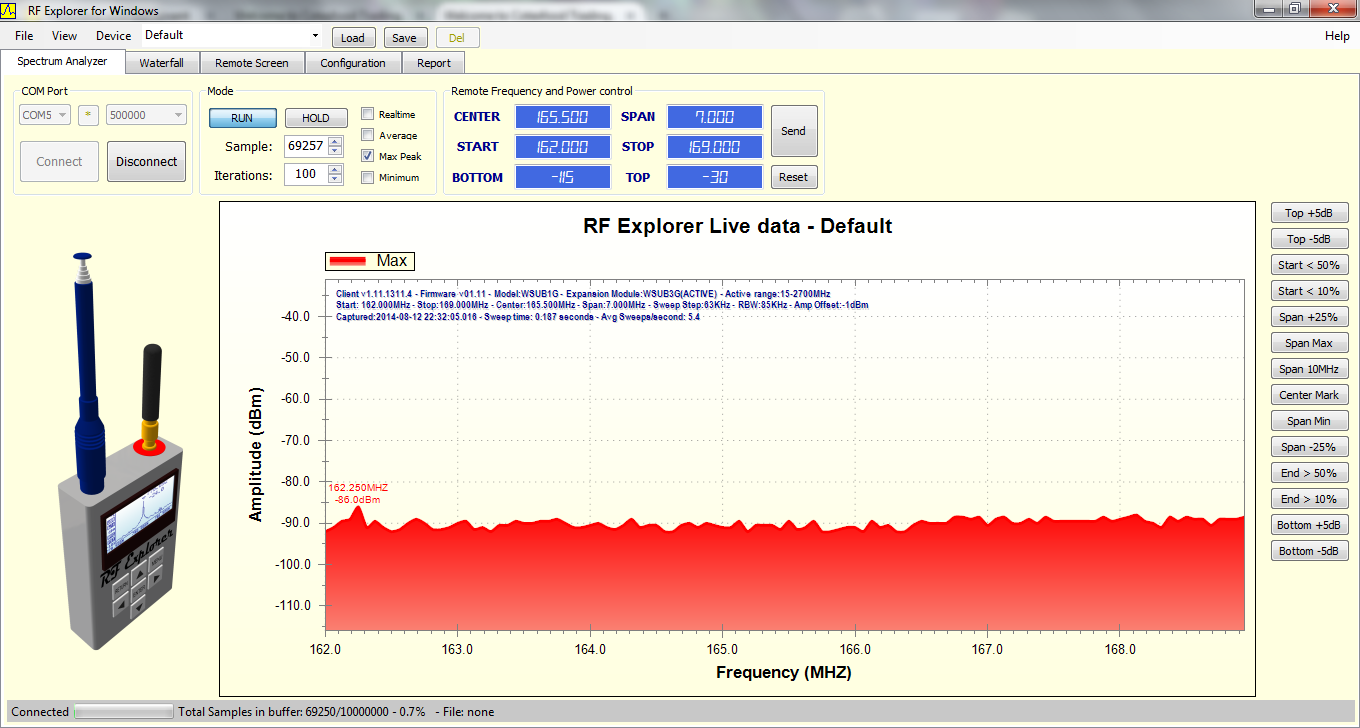
It is supplied with a dual band (Nagoya NA773 dual band 144/430MHz) SMA aerial which is fine for general VHF or UHF work (of course, a dedicated aerial for given ranges will perform best) and a SMA 2.4GHz aerial for WF-FI work. It actually has two modules, the right one covering 15 to 2700 MHz; the left one 240 to 960 MHz. You can switch from one to the other - which allows the current settings in the first one to be retained if you want to change between two ranges. But there is no provision for using both simultaneously, whether or not it is connected to a computer.
In Use
So - let's see it in operation. Modes are switched using the menu key. If you select the mode you want and press the left or right key, sub menus appear which allow you to set the essential parameters such as upper and
lower frequency, span and centre (set automatically when you have set the frequency range you wish to sweep), and also the dynamic range to display in DBmV. It defaults to -30 to -110 which is fine under typical measurement conditions. An important warning is in store here. This device is extremely sensitive, detecting down to -120DBmV. However, it is vulnerable to damage from high intensity RF sources. The maximum quoted safe input is +5DBmV. Ay input over this *risks causing damage* to the input stage so disconnect the aerials before you operate any transmitting equipment (or pass close to powerful RF sources). Even better, place in a metallic box or use sma 50 ohm terminators to provide better protection.
I tested it here in North London which is a very busy RF environment by sweeping a number of ranges. My first test was a sweep of 87.5 to 108 MHz. The FM brodcast band here is densely populated by both legal and pirate stations so the graph was very well populated; see the image below. This was produced using the RF explorer client for Windows which allows images to be saved as standard PNG files. The actual data exported from the spectrum analyser is saved in a propriety format (which can be read by the client software even by someone else without the RF Explorer as the software is freely available. Also it can be exported as a comma separated values file (.csv) to import into other applications.
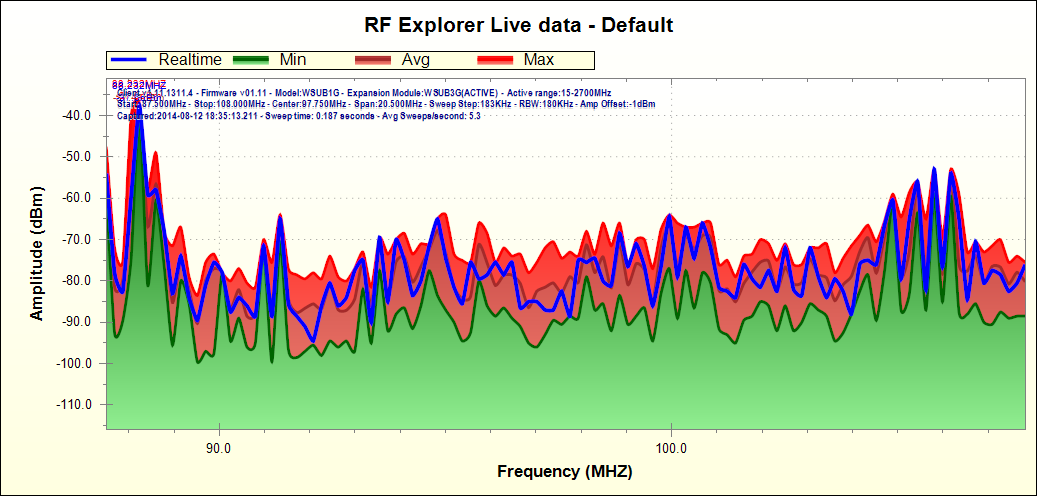
The software also allows a screenshot to be captured from the device itself.
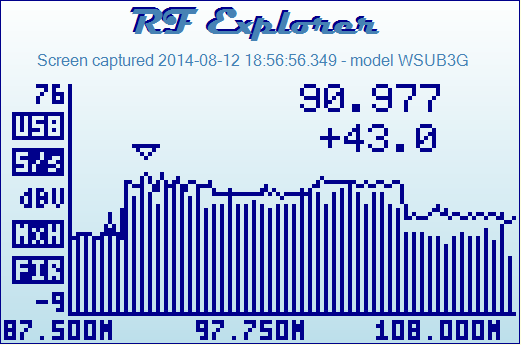
In another examaple, I did a similar sweep of the civil airband from 118 to 137 MHz.

As this device allows a maximum of 600MHz to be swept (although the resolution and refresh rates are low when sweeping this much spectrum) I decided to sweep 25 to 625 MHz which basically covers the spectrum of most interest to scanner enthusiasts, basically from CB radio up to the low end of the UHF television band. I have illustrated roughly where the main services and amateur bands lie, as best I can given the lack of space.

The software also allows a waterfall display to be produced which gives some idea how much activity there is over a period of time. In this example I chose to use the WI-FI spectrum just over 2.4GHz as transmissions are not continuous, hence giving a more illustrative display.
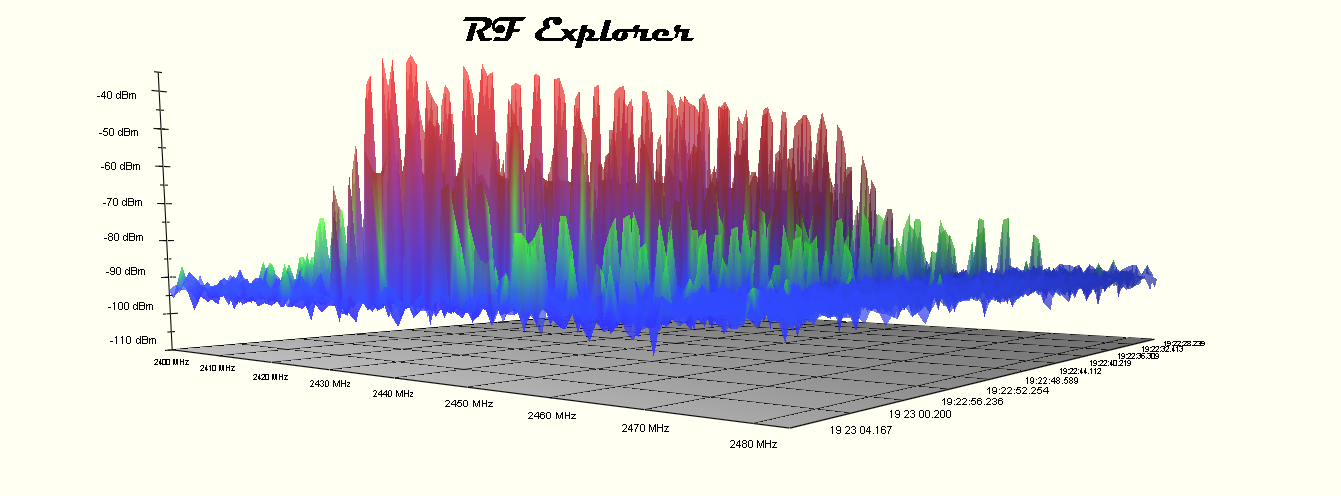
WI-FI Analyser mode
The WI-FI analyser mode is intended for those wanting to survey WI-FI usage in their locality in order to plan a new 802.11b/g network. For best performance, each access point must use a channel not identical or adjacent to those in use by adjacent access points. This includes those belonging to other peoples networks. I have a wireless network on this site; there are also a number of others in the vicinity. As you can see, the band is very busy (note however that other uses of the band exist besides WI-Fi; bluetooth, wireless camaras, video senders, baby monitors and domestic microwave ovens also radiate in the band).
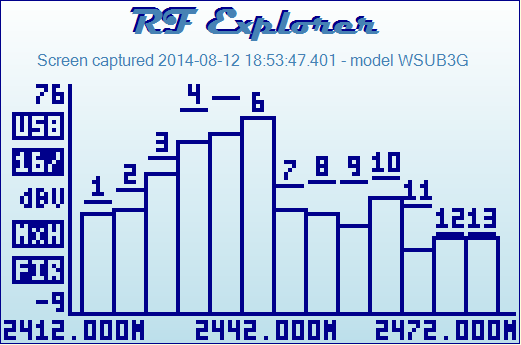
Finally, it is also possible to display this on the PC should you wish and as in spectrum analyser mode, you can also save the data and screenshots. Note that there appears no way to select WI-FI analyser mode from the PC; you must do so on the unit itself.
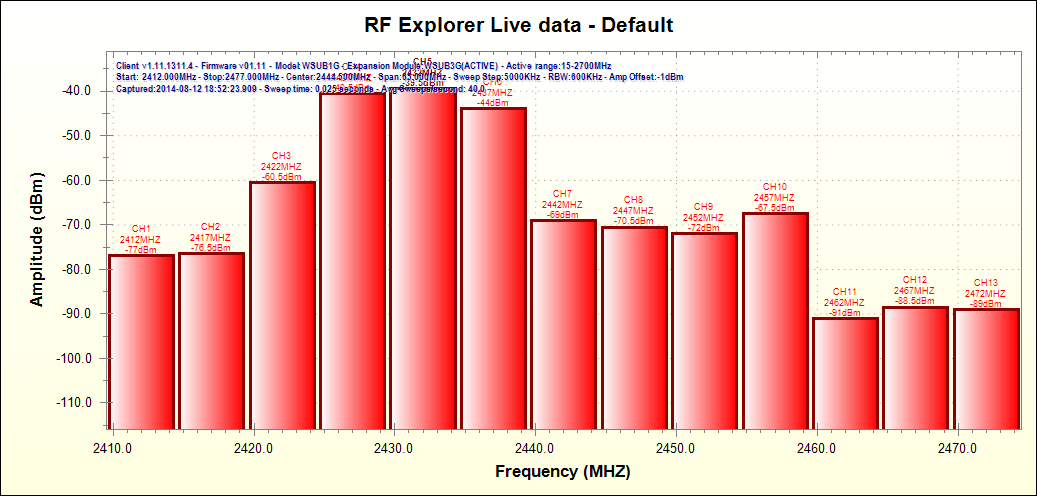
Signal generator mode
Some versions of the RF Explorer include a signal generator mode. As this is not inclueded in my version I could not test it.
Conclusion
When I have had more time to use this spectrum analyser further, I my be adding a few extra paragraphs to this page I am sure. The RF Explorer compares favourably to much more expensive spectrum analysers in terms of performance and is certainly going to appeal to both the hobbyist and professional user. At this price it brings an instrument of this kind into reach of the average radio amateur or scanner enthusiast for the first time. It is much more useful than cheap conventional frequency counters which in any case do not perform well in areas where there are more than one signal present of roughly similar strength. It will make tracking down sources of interference much easier (however heed my earlier warning regarding high signal strengths!), and will allow you to see what usage there is in a given area of spectrum over a period of many hours, as well as in'real time'. Although the controls take a little time to master out of the box, and can be confusing at first (it took me a while to master setting the sweep frequency range when using it standalone; i.e. without the use of a computer!); however, as with many of todays electronic devices, once mastered, operating it becomes second nature. Remember above all the old engineers proverb, RTFM!
The unit reviewed is the one which covers the most spectrum; other similar varients of this unit cover smaller areas of the radio spectrum, or just the WI-FI band. It should be noted that although this unit covers 15 MHz to 2.7GHz, which should cater for the majority of users' needs, it should be pointed out that no bands below 15 MHz (that's the 20 metre amateur band and lower bands) are covered, and most of us probably would not have much need above 2.7 GHz, except for perhaps the 5.8GHz band used by 802.11a WI-FI and some video applications (however, at these frequencies, range and building penetration are so minimal that high density useage presents few difficulties in my experience anyhow.
If you are thinking of buying one, check out the developers website for more information. If you already have one, I'll be interested to hear your views on it. My email address is at the top of the page. David, 12/08/2014.